Independence Missouri LDS Visitors Center
Introduction
Text-to-speech Audio
Images
Aerial view of Temple Lot: Community of Christ temple and auditorium: largest buildings. Church of Christ's building is the small white sided one in between the former. The LDS visitors center is the rectangular one near rounded top structure.
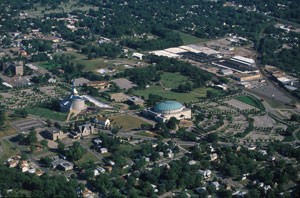
Temple lot are as it would have looked in 1833
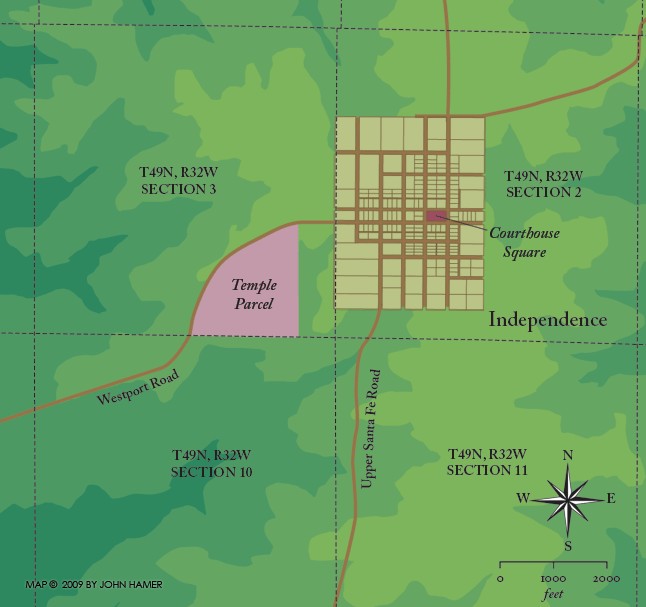
Inside Visitors Center

View of Temple Lot not constructed upin

LDS Independence Visitors Center
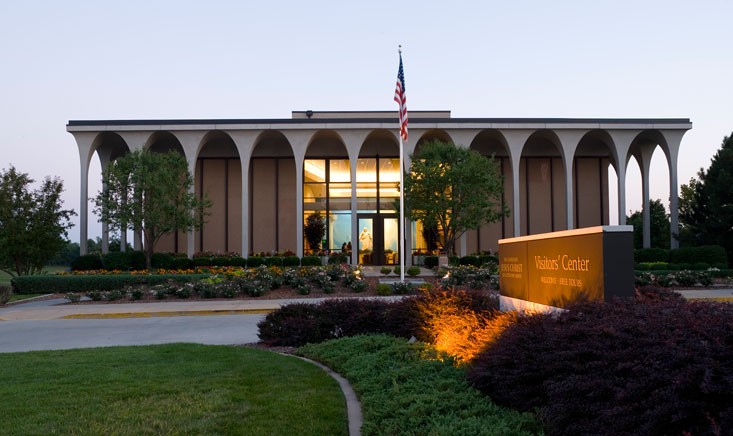
More of the inside
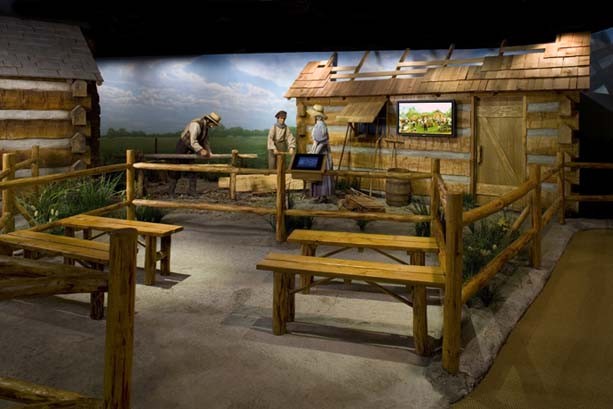
Painting depicitng some of the persecutions of the LDS members in Jackson County, where Independence is located
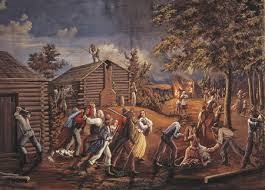
Depiction of the LDS members leaving Missouri in 1839
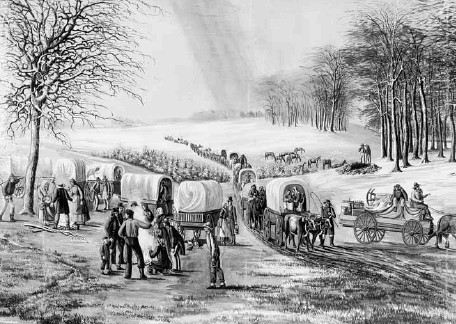
Backstory and Context
Text-to-speech Audio
Independence, Missouri was designated as a gathering place for the Saints in a revelation given to Joseph Smith, Jr. in 1831.1 The same revelation also revealed that the Independence area was Zion and advised the area where a temple was to be built “lying westward, up a lot which is not far from the courthouse.”2
Shortly after becoming a member of The Church of Jesus Christ of Latter-day Saints, W. W. Phelps was directed to purchase a press and begin publishing a newspaper in Independence, Missouri. In June 1832, the first issue of The Evening and Morning Star was published. Additionally, the first compilation of the revelations revealed to Joseph Smith, the Book of Commandments (now known as Doctrine & Covenants), was published here.
The location for the temple was dedicated on “a spot lying westward” under the direction of Joseph Smith. John Whitmer described the events of the dedication as follows:
'Sidney Rigdon dedicated the ground where the city is to stand: and Joseph Smith, Jr. laid a stone at the Northeast corner of the contemplated Temple in the name of the Lord Jesus of Nazareth. After all present had rendered thanks to the great ruler of the universe, Sidney Rigdon pronounced this Spot of ground wholly dedicated unto the Lord forever: Amen.' 3
The site where the cornerstone was laid and dedicated is located near present day River Street and south of Lexington Avenue.4
In July 1833, a mob of 400-500 individuals gathered at the Independence courthouse to discuss the problem of the growing presence of the Mormons. The mob decided that the printing office should be destroyed and razed the building to the ground.4
The mob then captured Bishop Edward Partridge and Charles Allen, and dragged them to the public square where they gave as ultimatum: deny the Book of Mormon or leave Jackson County. They each refused either choice and were subsequently tarred and feathered. Bishop Partridge described the event as follows:
'Before tarring and feathering me I was permitted to speak. I told them that the Saints had suffered persecution in all ages of the world; that I had done nothing which ought to offend anyone; that if they abused me, they would abuse an innocent person; that I was willing to suffer for the sake of Christ; but, to leave the country, I was not then willing to consent to it…
I bore my abuse with so much resignation and meekness, that it appeared to astound the multitude, who permitted me to retire in silence, many looking very solemn, their sympathies having been touched as I thought; and as to myself, I was so filled with the Spirit and love of God, that I had no hatred towards my persecutors or anyone else.' 6
When the mob attacked the printing office, the Book of Commandmentswas being published. Two young girls, Mary Elizabeth and Caroline Rollins picked up as many sheets as they could of the unbound revelations and hid in a cornfield until the mob departed. They each subsequently received a copy of the Book of Commandments which they highly prized the rest of their lives.5
The mob returned the next day and forced the leaders of the Church to sign an agreement to leave Jackson County before April 1, 1834. The events that transpired here led to the Battle of the Big Blue and eventually Zion’s Camp. However, the Saints were never able to reclaim their land."
Additional information:
The property upon which the Visitors Center stands was first purchased on December 19, 1831 by Edward Partridge, acting on behalf of Joseph Smith. It was repurchased by the LDS Church, which had become the largest of several different Latter Day Saint denominations, on April 14, 1904. The purchase was completed by James G. Duffin, President of the Central U.S. States Mission, acting on behalf of the First Presidency.
A few months later, the Kansas City Times published a rumor (but corrected itself the next day) that the so-called "Utah Mormons" had secretly purchased the entire Greater Temple Lot, including that portion owned by the Church of Christ (Temple Lot), which had been the subject of a lawsuit in the 1890s between the Temple Lot and (then) RLDS churches (now Community of Christ). The portion owned by the Temple Lot church was the highest-altitude 2.5 acres portion of the 63.5 acres originally purchased by Partridge in December, 1831, and had been repurchased by Granville Hedrick, founder of the Temple Lot church, between 1867 and 1877. Both pieces of real estate are often confused, because since 1867 both the 2.5-acre area and the larger 63.5-acre area have been described in newspaper and other media reports as the "Mormon Temple Lot." A January 2009 online article by Community of Christ researcher John Hamer entitled "The Temple Lot: Visions and Realities" helps clear up the confusion.
The Visitors Center opened in 1971, the same year as another particularly notable LDS Visitors Center, the LDS Visitors Center in Nauvoo, Illinois. Its style of presenting Mormon claims and doctrines in a modern audio-visual and interactive format was specifically the brainchild of LDS general authority Bernard P. Brockbank, who had overseen implementation of this same style at the 1964 New York World's Fair.
The Visitors Center is alleged to have been designed after the Parthenon, one of the world's most renowned temples. This has fueled speculation as to whether the LDS Visitors Center is, by definition, a temple constructed on the Greater Temple Lot dedicated and purchased by Joseph Smith and his associates for that purpose in 1831. An October 1952 Kansas City Times essay written by a friend and admirer of RLDS Church Historian Heman C. Smith (1850 - April 17, 1919) published the rumor that the LDS Church intended to build an LDS Temple on the site today occupied by the LDS Visitors' Center. In his 2004 book Images of New Jerusalem author Craig S. Campbell examines the rumor, but is skeptical the building may be "converted someday" into an LDS Temple.
While the LDS church operates a visitors center, the Church of Christ, Temple Lot has a small church building that also acts as visitors center and the Community of Christ constructed a type of temple on their portion of the lot that also contains a visitors center. Later the Community of Christ constructed a separate auditorium that took over much of the lot. Around the same time, another break off, the Remnant of the Church of Jesus Christ of Latter-day Saints, also constructed a building, this one a headquarters for the small church. While the grounds are contested, the churches have generally friendly relations, the Church of Christ, Temple Lot (at least), has a better relationship with the LDS church and has said on a visit to their center by the creator of this entry that when the day comes, they'd rather sell their portion to the LDS church.
LDS doctrine and belief holds that by Christ's Second Coming the church will have had while control of the lot and a temple built here as well in nearby Far West, Missouri. This belief helps the members of the LDS maintain hope in the literal and final fulfillment of Smith's prophecies regarding this area. Of course, violence will never be used to obtained this land by the LDS church or others that lay claim to it.
Other sides in this region of Missouri include Liberty Jail, Haun's Mill, Far West, Adam-Ondi-Ahman and sites of the Zion's Camp, a rescue party outfitted in Kirtland, Ohio to relieve the LDS members in Missouri from the persecutions they were suffering under.
